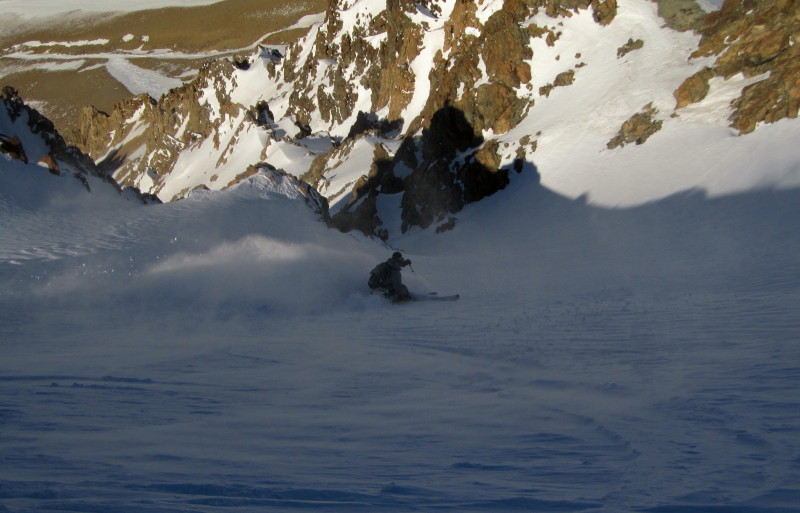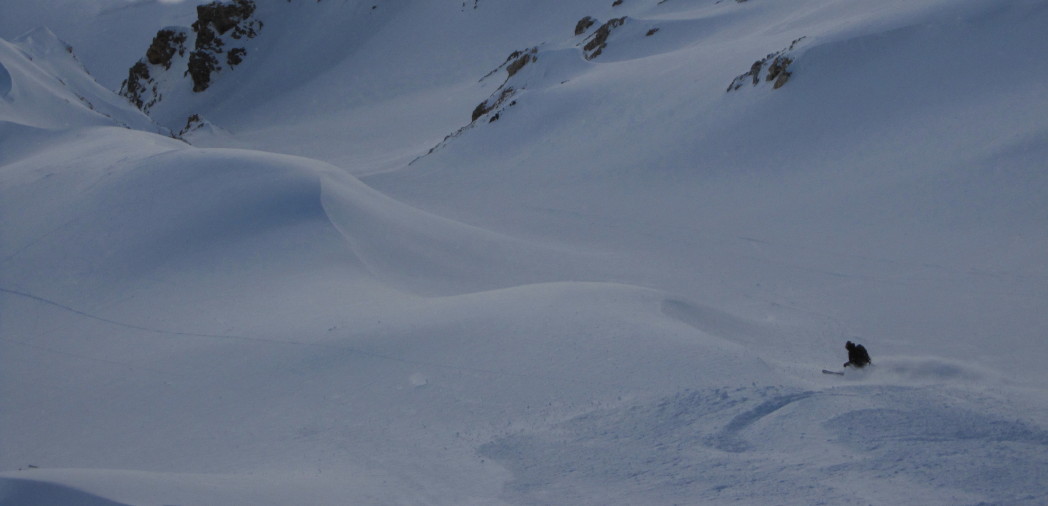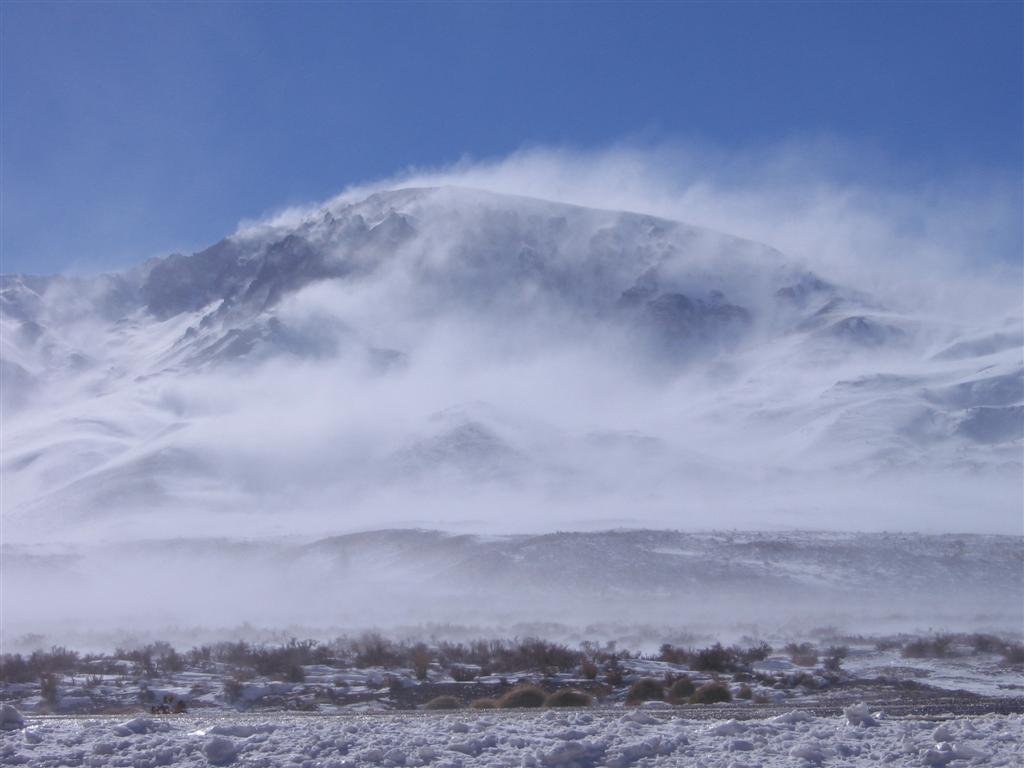You are using an out of date browser. It may not display this or other websites correctly.
You should upgrade or use an alternative browser.
You should upgrade or use an alternative browser.
Las Lenas and 2010 South America Season
- Thread starter soulskier
- Start date
Mike Bernstein
New member
Question - why is it that nearly all skiing in South America that I've seen is above treeline? Is the tree line lower in the Andes? I know there's some sub-alpine terrain further to the south near Patagonia, but it seems that the most heralded resorts, which are at similar latitudes as those in North America, are almost entirely above tree line.
I believe the native vegetation in the Southern Hemisphere is tropical in origin and won't grow in the alpine climate zones we ski in northern mountains. New Zealand's tree line is only 3,000 feet and it's a quite temperate climate with no place in the entire country more than 70 miles from the ocean. South Island ski area latitudes are similar to Bachelor or Jackson Hole. Even Australia, with its smaller and less rugged mountains topping out at 7,300 feet, has a tree line at ~6,000 at 37 degrees latitude (same as Mammoth or Telluride).
soulskier
New member
Mike Bernstein":3nwjsfc1 said:Question - why is it that nearly all skiing in South America that I've seen is above treeline? Is the tree line lower in the Andes? I know there's some sub-alpine terrain further to the south near Patagonia, but it seems that the most heralded resorts, which are at similar latitudes as those in North America, are almost entirely above tree line.
In the big Andes, from Las Leñas north, there are no trees, mostly because it is arid with huge wind. It is similar to the Eastern Sierra in a lot of ways, only bigger and minus the trees. BTW, the latitude of Las Leñas is comparable to Taos.
Yes, and the tree line at Taos is over 11,000 feet and nearly 12,000 a bit farther south at Santa Fe. New Mexico is not exactly a rainforest, so it has to be mostly the different native vegetation.soulskier":2vxnhgh0 said:the latitude of Las Leñas is comparable to Taos
Impact of wind is modest, maybe 1,000 or 2,000 max. The Sierra is a good example with Squaw/Alpine on the windy Sierra Crest, but a higher tree line at Heavenly and Northstar. And even there it's not all wind, some of the difference is due to the much higher snowfall on the Sierra Crest.
Snowfall volatility, clear spring days with freezing nights for optimal corn formation in the northern Andes ski areas are very similar to the Eastern Sierra.
soulskier
New member
Tony Crocker":2uwulx8t said:Yes, and the tree line at Taos is over 11,000 feet and nearly 12,000 a bit farther south at Santa Fe. New Mexico is not exactly a rainforest, so it has to be mostly the different native vegetation.soulskier":2uwulx8t said:the latitude of Las Leñas is comparable to Taos
Impact of wind is modest, maybe 1,000 or 2,000 max. The Sierra is a good example with Squaw/Alpine on the windy Sierra Crest, but a higher tree line at Heavenly and Northstar. And even there it's not all wind, some of the difference is due to the much higher snowfall on the Sierra Crest.
Snowfall volatility, clear spring days with freezing nights for optimal corn formation in the northern Andes ski areas are very similar to the Eastern Sierra.
After spending 3 full seasons in Las Leñas, I can safely say the wind in these parts is far stronger and more frequent than anywhere in the Sierras. I would respectfully disagree that it's impact is only modest, it howls here almost non-stop year round.
You might want to spend some more time at Mammoth before making that generalization. :lol:soulskier":3asd3wr5 said:I can safely say the wind in these parts is far stronger and more frequent than anywhere in the Sierras.
The mountain topography and prevailing wind direction are also important. For various reasons discussed before, Mammoth's wind contributes as many positives as negative to the ski experience there. I've also noted the difference in Alberta, where the wind is more a detriment at Sunshine while being more of a positive at Castle Mt. due to windward vs. leeward exposure.
Logically most of the slopes at Las Lenas should be leeward of a typical west-to-east flow. However, Extremely Canadian guide Joe Lammers told us that the wind there was very unpredictable in terms of direction. After every storm you need to get out and figure out where the snow got deposited. I was there in a high snow year 2005 and did not see the big cornices typical at places like Mammoth. Joe said that was due to it not blowing consistently in the same direction.
What I saw in Chile looked more like prevailing wind effect. La Parva showed much evidence of direct wind exposure while a few parts of Valle Nevado and the backside of El Colorado look like they get more wind deposition. Portillo did not show much evidence of wind effect when I was there although I'm sure there are storms where it gets plenty.
soulskier
New member
Tony Crocker":19ntngmq said:You might want to spend some more time at Mammoth before making that generalization. :lol:soulskier":19ntngmq said:I can safely say the wind in these parts is far stronger and more frequent than anywhere in the Sierras.
Tony, do I need to send you my resume? I spent 18 years in the Sierras before relocating to the Andes. I grew up skiing Mammoth. And I have skied over 75 peaks from Lone Pine to Bridgeport, in the Eastern Sierra. So it isn't a generalization.
Here's one from today.

Patrick
Well-known member
soulskier":b66h8jsu said:Tony Crocker":b66h8jsu said:You might want to spend some more time at Mammoth before making that generalization. :lol:soulskier":b66h8jsu said:I can safely say the wind in these parts is far stronger and more frequent than anywhere in the Sierras.
Tony, do I need to send you my resume? I spent 18 years in the Sierras before relocating to the Andes. I grew up skiing Mammoth. And I have skied over 75 peaks from Lone Pine to Bridgeport, in the Eastern Sierra. So it isn't a generalization.
Soul 1
Tony 0
:mrgreen:
Don't worry, I return a discussion a while ago where Tony was the only one versus very one else including Admin on Eastern Spring Snow. Again Tony, you can't win here. I would take Soul word based on his experience.
Some of you may remember my reports from New Year's 2006: viewtopic.php?t=1573

I would not dispute that the impact of wind upon skiing is more negative at Las Lenas than at Mammoth.
1) Mammoth's upper lifts are leeward of prevailing winds while they are frequently crosswise to Marte.
2) Mammoth does have trees on the lower half of its vertical. Adam can vouch for some impressive storm skiing powder days this past season, though there are times like my 2006 example above where the wind is so pervasive that there is not much powder left when the storm is over.
3) Windy days at Mammoth usually shut down 1/4 to 1/2 of terrain with just a handful of severe days as much as 3/4. Any windy day at Las Lenas Marte is down, which means 3/4 of terrain.
With regard to where the wind is "far stronger and more frequent" I'm not so sure. Mammoth upper gondola and chair 23 are closed for wind about 30% of the time by my 33 years and 250+ days of experience despite their leeward placement. Mt. Bachelor's Summit lift, which has a crosswind placement like Marte's, is closed about half the time during the winter months, not so different from Marte.
My impression is that wind is most frequent and consistent near the top of isolated peaks like Mammoth and Bachelor. But it's probably more localized; when it blows at Las Lenas it's more likely to affect most or all of the mountain.
Interestingly, during my 2005 week at Las Lenas I experienced little wind while skiing, though the snow conditions sometimes offered ample evidence that it had blown hard overnight.
I would not dispute that the impact of wind upon skiing is more negative at Las Lenas than at Mammoth.
1) Mammoth's upper lifts are leeward of prevailing winds while they are frequently crosswise to Marte.
2) Mammoth does have trees on the lower half of its vertical. Adam can vouch for some impressive storm skiing powder days this past season, though there are times like my 2006 example above where the wind is so pervasive that there is not much powder left when the storm is over.
3) Windy days at Mammoth usually shut down 1/4 to 1/2 of terrain with just a handful of severe days as much as 3/4. Any windy day at Las Lenas Marte is down, which means 3/4 of terrain.
With regard to where the wind is "far stronger and more frequent" I'm not so sure. Mammoth upper gondola and chair 23 are closed for wind about 30% of the time by my 33 years and 250+ days of experience despite their leeward placement. Mt. Bachelor's Summit lift, which has a crosswind placement like Marte's, is closed about half the time during the winter months, not so different from Marte.
My impression is that wind is most frequent and consistent near the top of isolated peaks like Mammoth and Bachelor. But it's probably more localized; when it blows at Las Lenas it's more likely to affect most or all of the mountain.
Interestingly, during my 2005 week at Las Lenas I experienced little wind while skiing, though the snow conditions sometimes offered ample evidence that it had blown hard overnight.
soulskier
New member
Tony Crocker":3f11oqso said:I would not dispute that the impact of wind upon skiing is more negative at Las Lenas than at Mammoth.
With regard to where the wind is "far stronger and more frequent" I'm not so sure.
Maybe you miss understood me, or don't quite understand my point, which is the huge and frequent wind is big contributing factor in why there are no trees in Las Leñas, per Mike's question.
The wind actually assists with the great skiing Las Leñas offers. During your week, maybe your guide Joe took you on some really smooth runs? The key to skiing down here is to use the wind to it's advantage. The windbuff that forms here is among the best on the planet. Think Chair 23 but only for much more vertical. Also, the corn forms very fast as a result of quick consolidation of the snowpack due to the aforementioned wind, along with low latitude and a very strong sun.
As far as the wind being far stronger and more frequent, you will need to trust me on this. I speak from experience. It's like me arguing with you on when Highway 134 has traffic and when it doesn't.
soulskier
New member
Tony Crocker":304k9crg said:1) Mammoth's upper lifts are leeward of prevailing winds while they are frequently crosswise to Marte.
That goes against your earlier hypothesis that the wind blows from all directions at Las Leñas.
The reason Marte chair is closed so much is because it is a 1983 double chair that has been wiped out many times, there is incompetent management (especially since Jeff Eckland is no longer here) that doesn't consider running it a priority, and it is placed in the windiest spot in the valley, and perhaps the whole Andes!
Here's one from yesterday.

Sorry to hear Jeff Eckland isn't there anymore. He provided useful info last year which I passed along to FTO: viewtopic.php?f=6&t=8266.
In that discussion it became quite clear that the placement of Marte would severely limit its operation even if management were more competent. I find it noteworthy that soulskier still finds Las Lenas skiing in a low snow year more interesting than Bariloche in an above average year.
In that discussion it became quite clear that the placement of Marte would severely limit its operation even if management were more competent. I find it noteworthy that soulskier still finds Las Lenas skiing in a low snow year more interesting than Bariloche in an above average year.
The wind and leeward side aridity undoubtedly explain why even at lower elevation as you drive up from Malargue you see few trees. But with regard to ski elevations the low tree line on the Chilean side, and particularly in New Zealand, which is not arid at all, argue for the Southern Hemisphere native vegetation being significantly different from North America.soulskier":1p4sts6g said:the huge and frequent wind is big contributing factor in why there are no trees in Las Leñas, per Mike's question.
soulskier
New member
Tony Crocker":3gd5550b said:I find it noteworthy that soulskier still finds Las Lenas skiing in a low snow year more interesting than Bariloche in an above average year.
That's like comparing Squaw Valley to Mount Waterman. Even though it's been low tide in the big Andes, there has been some amazing skiing at Las Leñas. Bariloche just doesn't have the terrain available for my wife and I's liking, regardless of the amount of snow.
Once Leñas closes, we will head back south to finish our ski sabbatical. I'll be sure to post some pics, including some trees.
Which does raise the question why someone would pay the big $ to go there from the Northern Hemisphere, especially more than once. :stir: My son Adam has expressed exactly the same sentiment as soulskier with respect to Las Lenas terrain quality vs. other Southern Hemisphere ski areas.soulskier":s8js03yt said:Bariloche just doesn't have the terrain available for my wife and I's liking, regardless of the amount of snow.
Patrick
Well-known member
Tony Crocker":1luksyya said:Which does raise the question why someone would pay the big $ to go there from the Northern Hemisphere, especially more than once. :stir: My son Adam has expressed exactly the same sentiment as soulskier with respect to Las Lenas terrain quality vs. other Southern Hemisphere ski areas.soulskier":1luksyya said:Bariloche just doesn't have the terrain available for my wife and I's liking, regardless of the amount of snow.
Meet a bunch of people that dont want to go to LAs Lenas for a number of reasons. They are Americans, Canadians and French and come to Argentina to ski. No time to get into details, but Im sure Soulskier knows the reasons.
Mostly TISA, I would guess. But other areas are not immune from that. http://www.tetongravity.com/forums/show ... p?t=195632
Snowfall update as of Sept. 2:
Portillo 130 inches
Valle Nevado 155 inches
At Portillo that's 8 inches in the past 4 weeks, base depths 21-32 inches. Not good. Note also that Portillo reports lower snowfall than Valle Nevado. Not the normal pattern, maybe La Nina related due to Portillo's lower latitude?
Portillo 130 inches
Valle Nevado 155 inches
At Portillo that's 8 inches in the past 4 weeks, base depths 21-32 inches. Not good. Note also that Portillo reports lower snowfall than Valle Nevado. Not the normal pattern, maybe La Nina related due to Portillo's lower latitude?
Tony Crocker":34s63jq8 said:At Portillo that's 8 inches in the past 4 weeks, base depths 21-32 inches. Not good.
http://www.firsttracksonline.com/News/2 ... w-Zealand/
http://www.firsttracksonline.com/News/2 ... -Glaciers/

